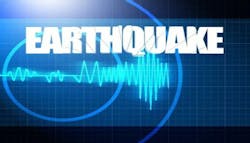A Major Earthquake is Likely Near, Here’s How to Protect Critical Networking Equipment
In this week’s Voice of the Industry, Sam Rodriguez, Sr, Product Manager of Cabinet & Thermal Solutions at Chatsworth Products, shares how to protect up to 1500 lb of critical network equipment without sacrificing flexibility.
Sam Rodriguez, Sr., Chatsworth Products.
Earthquake scientists gathered at the National Earthquake Conference early this month to share the latest on seismic news, best practices and technologies. A major consensus was that the San Andreas Fault is long overdue for a major earthquake as big as magnitude 8.
A big earthquake like this causes billions in damage, and Southern California residents and businesses should start preparing, experts advice. Critical Network Equipment Must be Safe
When it comes to data center planning, it is much easier to prepare for the next earthquake, than to predict when it will happen. This is especially important in telecommunications and equipment rooms and data centers that cannot afford to be offline or are not backed up at a secondary location.
Selecting the right infrastructure products for your data center is crucial in order to get the most protection for servers, switches and cables. Specialized equipment and accessories such as racks, cabinets and bracing help minimize excessive motion that may cause undue strain on cable and network connections.
How Building Codes Affect Seismic Rating of Products
Because seismic areas require specific building codes and installation requirements for public buildings to ensure the safety of people and equipment, seismic products installed in buildings must also comply with stringent guidelines.
Organizations such as the International Building Code (IBC), American Society of Civil Engineers (ASCE) and California Building Code (CBC) expect that:
- Seismic-rated structures have a low to no likelihood of collapsing during a seismic event.
- Nonstructural components need to comply with strict calculations so that they don’t slide or overturn in the event of an earthquake.
- Critical facilities must continue to operate even after an earthquake. These are what the IBC categorizes as Category IV, as they represents a substantial risk to human life if they’re not working. Think hospitals, fire and police stations, emergency rooms, airplane towers, etc.
- Components and nonstructural elements that are going to be installed in the facility also get a grade—the component factor (Ip), which tells an engineer if there is a need for a special floor design or installation practice.
Why Seismic Qualification Matters
There are three different ways manufacturers can claim their products are qualified to perform in seismic areas:
- Analysis and design calculations – take into consideration the importance factor of the component and Risk Category of the facility, among other variables.
- Shaker table testing – tests products on a physical level with very stringent conditions, simulating a severe earthquake, ensuring the product will perform before, during and after an earthquake.
- Experience data – requires manufacturers to submit evidence that the product has performed through a severe earthquake.
Installers and contractors must look closely at the type of seismic rating a manufacturer is providing, as there are different methods to achieving a seismic rating for a product. IBC compliance certification takes into consideration the products and their interaction with the entire building. Approval is either achieved through a specific mathematical equation or through experience data.
Another common and widely sought after seismic certification is the Telcordia Technologies GR-63-CORE Network Equipment Building Systems (NEBS), which provides a set of directives to ensure the protection of telecommunications equipment. NEBS requires an enclosure to provide a level of protection for equipment so that it maintains operation during and after a seismic event. Unlike the IBC certification process, which is based on analysis, NEBS tests products on a physical level with very stringent conditions to help prevent system downtime. Putting a product through a simulated earthquake is the most realistic way to verify its seismic performance.
Shaker Table Simulation
To get a NEBS certification, the enclosure is loaded to maximum capacity and mounted on a shaker table. Anchorage, bracing and accessories required during actual product installation are also addressed in the test. The shaker table simulates an earthquake (up to 8.3 on the Richter scale) and shakes the enclosure front-back, side-side and up-down at different levels of intensity. To pass the test, the enclosure must not move more than three inches at the top of the enclosure, relative to the base in each direction, and it must maintain operation during and after the shaker test. (Click here to watch a server cabinet being tested.) In the state of California, the Office of Statewide Health Planning and Development (OSHPD) also provides special seismic certification to products that will be installed in hospitals and health care facilities.
Many data centers in California and around the globe rely on manufacturers to engineer top performance products of the highest quality and standards, so that companies can rest assured that critical networks will be minimally affected during a strong earthquake. Seismic events continue to draw attention on a global scale, acting as a catalyst for ever-increasing building codes and certifications. Be sure to check all codes, rules and regulations in your area, and consult a structural engineer when necessary.
As crucial as complying with building codes is, understanding what goes behind deeming a product seismic-ready is also important, as different approaches are used to make such determinations.
Submitted by Sam Rodriguez, Sr, Product Manager of Cabinet & Thermal Solutions at Chatsworth Products. Prevent downtime and equipment damage during a seismic event, and plan accordingly with IT infrastructure products and accessories, specifically designed to protect equipment in seismically active areas. Learn more at Chatsworth Products.


